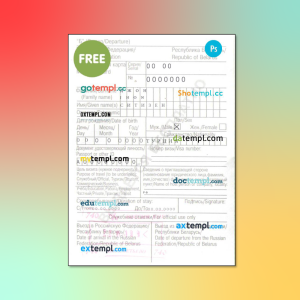In an era of globalization and increased mobility, the migration card has emerged as a powerful tool, facilitating the movement of people across borders while ensuring compliance with immigration regulations. A small but significant document, the migration card carries immense value, streamlining processes, and fostering international cooperation.
The migration card serves as a gateway to new opportunities, allowing individuals to explore different countries, cultures, and experiences. Whether for work, study, or leisure, this essential document enables smooth entry and exit, creating a harmonious bridge between nations. Providing necessary information about travellers, it ensures that immigration authorities can efficiently manage arrivals and departures.
One of the primary functions of a migration card is to collect relevant data from travellers. Typically, it includes personal details such as name, nationality, passport number, and purpose of visit. This information assists authorities in maintaining accurate records and monitoring the movement of individuals. It allows governments to make informed decisions regarding immigration policies and security measures.
Moreover, the migration card plays a crucial role in enhancing national security. Screening incoming and outgoing travellers, it helps identify potential risks, ensuring the safety of both citizens and visitors. The data collected through migration cards can be cross-referenced with watchlists and databases, enabling authorities to identify persons of interest and take necessary precautions. This contributes to the overall stability and well-being of a country. 📌
Beyond security concerns, the migration card also promotes economic growth and cultural exchange. It facilitates the entry of skilled professionals, students, and tourists who contribute to the local economy. Additionally, it enables individuals to immerse themselves in foreign cultures, fostering mutual understanding and appreciation. Such intercultural exchange leads to the enrichment of societies and promotes peaceful coexistence. 📍

In recent years, several countries have embraced technology to streamline the migration card process. E-visas and digital platforms have revolutionized the way travellers provide their information, reducing paperwork and minimizing waiting times. These advancements not only enhance efficiency but also reduce the environmental footprint associated with traditional paper-based systems. ✅
However, it is important to ensure that the migration card process remains accessible and inclusive. Governments should prioritize user-friendly interfaces and multilingual options to accommodate individuals from diverse backgrounds. Additionally, proper training should be provided to immigration officers to ensure a welcoming and respectful experience for all travellers.
While the migration card has undeniably simplified international travel, it is crucial to strike a balance between security measures and individual privacy. Governments should adopt robust data protection protocols and adhere to international privacy standards to safeguard personal information collected through migration cards. Transparency and accountability in handling this data are imperative to maintain public trust.
download here: click
In conclusion, the migration card is a catalyst for global mobility and harmonious coexistence. Its role in facilitating travel, ensuring security, and promoting cultural exchange cannot be overstated. As we continue to embrace the benefits of globalization, it is essential to refine and modernize migration card processes, keeping in mind the principles of inclusivity, efficiency, and respect for privacy. By doing so, we can create a world that embraces diversity and unlocks the true potential of human connections.
